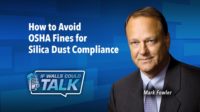A Look into OSHA's new Silica Rule
Silica: Are You Prepared?

There are myths and urban legends about OSHA’s new silica rule. The facts are the Department of Labor has instructed OSHA to proceed with enforcing the tough silica exposure rule. Efforts to reverse, ban or alter the rule have so far been unsuccessful. What will OSHA be looking for? The Department of Labor recently put out a sheet providing compliance officers guidance on investigating silica concerns on construction sites. The inspection procedure is not a secret. Using Google search “interim silica enforcement guidance,” click on the Oct. 19, 2017 DOL directive. You can also contact the Stucco Manufacturers Association for a copy.
Under the Lens
A task that has an exposure to Respirable Crystalline Silica over 25 micrograms as an 8-hour time weighted average is subject to the ruling. Only tasks that can be verified as below 25 are exempt from “action.” The Permissible Exposure Limit is 50; this is a reduction from 250. Creating dust with materials such as concrete, drywall, cement, masonry or stucco are now going to be under scrutiny.
Do You Have a Plan?
The myth that if the task is not listed by OSHA in Table One infers exemption is in contradiction to the enforcement guidance flow chart. Flow Chart A starts by asking “is the task in Table One?” If the answer is no, “go to flow Chart B.” Flow chart B asks if the task is verified as being below the Action (25) Level. It is strongly recommended you review the ruling, small entity guide or the enforcement guidance letter to become familiar with the rules of compliance. Fines can start at $12,000 and quickly escalate. Enforcement has begun.
Producing a written exposure plan related to your workers tasks is step one for compliance. You can write your own plan by going to www.silica-safe.org. Click on “Create-a-Plan” and select materials and tasks, such as grinding, cutting, mixing cement, etc. Many associations offer prepared plans for their members. The next step is to assign a competent person. The competent person has three main duties.
1. Be able to identify silica risks or potential silica risks;
2. Have the authority to correct the problem;
3. Have knowledge of the written exposure plan and how to implement it.
The Task at Hand
There is no required training for the competent person; it is up to the employer to decide who is competent. Many outsiders are starting to offer training. OSHA seems to prefer trade-specific training as it is directly related to the task of that trade. OSHA is also not in favor of employers simply handing out respirators. Mandatory use of respirators also adds hosts of additional requirements; engineering controls or work practices are preferred.
Table One from OSHA has 18 tasks and are exempt from testing when all stated controls are implemented. If the task is not on Table One, you must verify the task is below the Action Level through testing or industry data. This is found on flow chart B. These tasks fall under the performance or monitoring option. The monitoring option essentially means you are going to test each worker and provide data that is available for review.
The SMA plan involves tested tasks or historic data in plastering and/or manufactured adhered masonry. For example, the task of mixing mortar or stucco is not part the OSHA Table One, but is historically known to exceed the action level of 25. In some cases, data reveals the exposure exceeded the PEL. The University of Washington published a report that as a standalone task, mixing cement or concrete had a mean average of 57 micrograms as an 8-hour time weighted average.
Are You Prepared?
The SMA will stay on this issue and per the ruling, update the written plan annually as required for members. While fall protection and scaffold will likely continue to be the focus for compliance, having the written plan and educating your workers is good insurance. Similar to insurance, buying it after the accident does not help. Claiming ignorance of the silica rule will not be a viable defense. If your national association has no written plan for you on your tasks, you would be wise to go to the OSHA website and create one yourself.
Terms like other-than-serious or willful are pretty clear as to how the employer chooses to act and likelihood of winning an appeal.
Looking for a reprint of this article?
From high-res PDFs to custom plaques, order your copy today!






